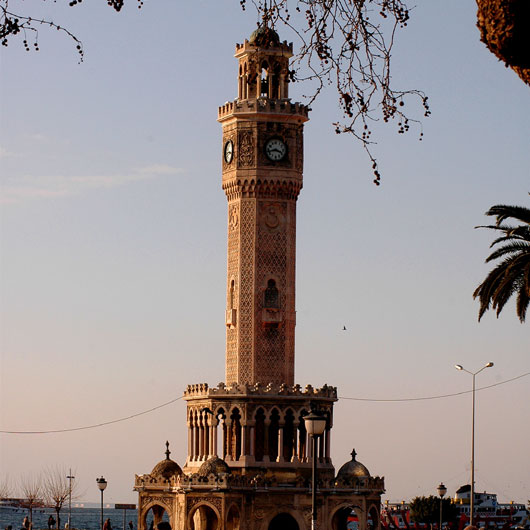Clock Tower

The Clock Tower, a beautiful symbol of Izmir, was built in 1901. The 25th anniversary of Abdülhamid II’s (reig¬ned 1876–1909) accession to the throne conduced to building clock towers in Ottoman cities and towns. In 1317 of the hegira (1899-1900) Abdulhamid II issued a decree ordering clock towers built in several Ottoman cities in his name. Upon this order, several clock towers were erected throughout the country most of which would become symbols of their cities over time. It must be highlighted that it was also closely related with the country’s westernization process.
İzmir Clock Tower located in Konak Square is an extre¬mely elegant work of art. It is 25 metres high and has four storeys. It stands on a four step, cross-shaped marble platform that has an octagonal plan and covered 81m² of land. Public fountains were placed on top of four small columns at every narrow corner of the octa¬gonal platform. The public fountains, with horseshoe-shaped arches, are baldachin shaped, and the basins with three fountains each, have a sprinkler in the middle. Two of the sprinklers no longer exist today. Decorated domes cover the baldachins. The four facades between the public fountains have horseshoe-shaped arches and iron network opening; the one towards the sea is the door to the opening.
A scalloping canopy surrounds the tops of the public fountains and facades with great elegance. The platform of the tower is white marble, while the other sections are built from cut stone. The body rises in the shape of a square prism from the bevels on top of the columned gallery, on the octagonal base. Columns with the narrow capitals and small bases are connected to one another with three-sliced arches. The green and pink coloured capitals and corners of the columns, used on the gallery and fountains, are adorned with botanic decorations.
All facades of the body have small alcove windows, with horseshoe-shaped arches. The ones to the east and west have small Ottoman coats of arm, and the ones to the north and west have the signature of Sultan Abdülhamit II embossed on them. After the Republic was declared, the Sultan’s signature and coat of arms were replaced with the star and crescent. Its body is decorated with diamond-shaped reliefs that contained pentagrams. The upper section of the body was exten¬ded by three lines of muqarnas, and four clocks, with a diameter of 75 centimetres, presented by German Emperor Wilhelm II.
The main mechanic body of this clock is placed on spe¬cial iron gussets and cast iron legs. The date 1901 can be seen on some parts of the 22-gear clock. The fourth floor that sits on twelve columns is narrow bodied and covered with a crescent decorated metal dome, and is where the bell, which no longer works, is located.